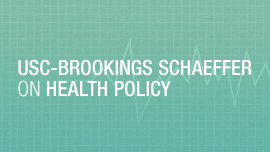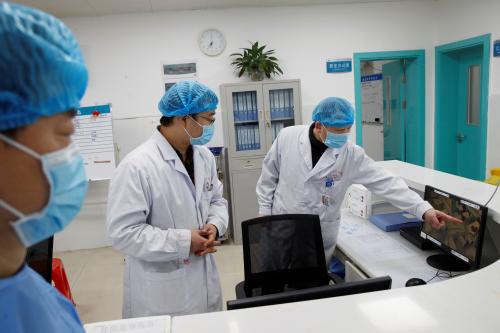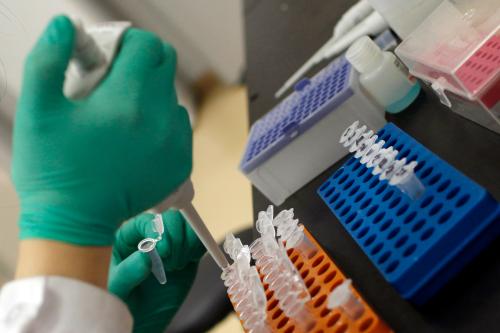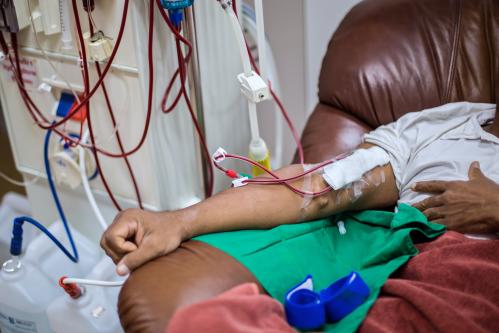This analysis is part of the USC-Brookings Schaeffer Initiative for Health Policy, which is a partnership between Economic Studies at Brookings and the University of Southern California Schaeffer Center for Health Policy & Economics. The Initiative aims to inform the national health care debate with rigorous, evidence-based analysis leading to practical recommendations using the collaborative strengths of USC and Brookings.
The Families First and Coronavirus Relief Act (FFCRA), as amended by the Coronavirus Aid, Relief, and Economic Security (CARES) Act, provides that testing for the detection of SARS-CoV-2, the virus that causes COVID-19, and the associated office, urgent care, or emergency room visit shall be free to the patient, so long as the federally-declared public health emergency is in effect. This protection applies to virtually every form of health coverage, including Medicare, Medicaid, and private insurance (other than some forms of coverage, such as short-term plans, that are exempt from much insurance regulation). Federal law also establishes a fund that will pay for tests delivered to uninsured patients if a provider chooses to seek reimbursement.
Unfortunately, since enactment, a number of press reports have highlighted examples of insurers, employers, and providers not following the law. Some of this likely stems from uncertainty in how to interpret the law or about its existence, while some may reflect efforts to skirt their legal obligations. Recent guidance put forward by the Trump administration adds some clarification, but also leaves a few important questions unanswered.
Clarifying and enforcing existing law is important, but more is also needed to guarantee financing for COVID-19 testing that promotes public health goals.
This blog aims to clarify the existing laws and guidance governing payment for COVID-19 testing, highlight ambiguities, and suggest improvements.
What the law requires
The FFCRA specifies that all COVID-19 testing approved by the Food and Drug Administration (FDA) or for which emergency use authorization (EUA) has been requested (until the EUA has been ruled on) and any associated medical services shall be covered by Medicare, Medicaid, and private insurance without any cost-sharing requirements for the patient. Coverage must be provided without “prior authorization or other medical management requirements.” In addition, the costs of testing and associated medical services for the uninsured can be paid through the National Disaster Management System (NDMS) at 110% of Medicare rates, and a state can opt to cover these costs for uninsured patients through their Medicaid program (with the costs effectively reimbursed in full by the federal government).
Additionally, Sec. 3202 of the CARES Act requires commercial insurers to pay for out-of-network testing at whatever dollar amount the provider publicly lists as the “cash price” on their website. Note that the term “cash price” in this instance has little meaning since all COVID-19 tests can be free at the point of sale to all patients. Trump administration guidance (Q9) interprets the combined FFCRA and CARES Act provisions as prohibiting testing entities from balance billing beyond publicly-listed “cash price” amounts for test services. Further, providers who accept CARES Act provider relief funds are not allowed to balance bill any presumptive COVID-19 patient (including a patient seeking testing) for out-of-network covered medical services.
Recent Trump administration guidance attempts to clarify how insurance companies and group health plans should implement these requirements. The guidance documents explain that the mandate to cover testing with no cost-sharing applies to all types of COVID-19 diagnostics – PCR tests, antigen detection tests, and serology tests – including when a patient is asymptomatic. However, the guidance also interprets the statute to apply only to testing done for “diagnostic purposes” and “when medically appropriate for the individual, as determined by the individual’s attending health care provider in accordance with accepted standards of current medical practice.” The agencies have defined an “attending health care provider” as any licensed provider making an “individualized clinical assessment.” The guidance further specifies that at-home testing ordered by a medical professional must be covered at a cost of $0 to the patient.
On the other hand, the guidance says that health plans need not cover testing done for general workplace safety or public health surveillance, because these tests are not for “individualized diagnosis or treatment.” Health plans are not required to reimburse for tests that an individual is required to obtain to, for example, return to work or school, which means workers and students may be expected to pay for those tests themselves. Together, this creates some ambiguity about coverage for tests conducted at “drive-through” or other general access sites or in circumstances where a patient has no specific reasons to suspect exposure but wants to be sure of a negative result (such as before visiting family). Has a clinician ordering a test at a drive-through site made a sufficiently “individualized” determination? Does seeking peace of mind before interacting with others constitute a “diagnostic purpose” or a “surveillance” purpose? Arguably, the most natural read of the guidance would suggest coverage should be provided in these circumstances, but some payers may continue to otherwise interpret agency statements.
What isn’t allowed
Judging by stories in the press and conversations with stakeholders, it is clear that some insurers, employers, and providers are skirting the law. Consumers are being billed – sometimes thousands of dollars – for services where existing law clearly prohibits it. Widespread news coverage of these cases may deter others from seeking testing, so it is important for policymakers to understand these shortcomings so they can promote widespread compliance. We note four legal requirements, in particular, where unlawful consumer bills have emerged:
- Out-of-network testing entities cannot balance bill patients. It was initially unclear whether a testing entity, such as Gibson Diagnostic Lab, could balance bill for the difference between their charges (or list price) and the publicly-listed “cash price,” but recent Trump administration guidance clarifies that this action is prohibited.
- Health plans cannot decline to cover office, telehealth, urgent care, or emergency room visit that results in an order for a COVID-19 test and cannot charge any cost-sharing from the patient. This requirement applies to the “administration” of a COVID-19 test and all “items and services furnished to an individual” during visits “that result in an order for or administration of a [COVID-19 test].” Recent guidance clarifies that this requirement includes services to determine whether a COVID-19 diagnostic test is necessary, such as a flu test or chest x-ray, if a COVID-19 test is subsequently provided. Out-of-network services also must be covered without cost-sharing, although the out-of-network provider can subsequently balance bill the patient for the visit or associated services (but not the test itself).
- Health plans cannot exclude serology testing done for “individualized” diagnostic purposes when ordered or administered by a medical professional, nor can they exclude testing for asymptomatic patients with suspected exposure.
- Self-insured employer health plans cannot escape these requirements. The statute and Trump administration guidance are crystal clear that all the COVID-19 testing coverage rules apply equally to self-insured employer health plans. Astoundingly, we have heard reports of self-funded plans claiming that the law does not apply to them and the CEO of the National Alliance of Healthcare Purchaser Coalitions admitted as much to California Healthline.
Where current law falls short
Clarifying and enforcing the existing laws is important, but there will still remain critical gaps in access to and support for COVID-19 testing.
Billing of uninsured patients
Under current policy, a provider has the option to seek reimbursement from the federal government for testing an uninsured patient, but is not required to do so. Therefore, some uninsured patients may still end up getting billed for COVID-19 testing, or avoid testing out of fear of being billed.
Perverse incentives for out-of-network test pricing
The CARES Act mandates that commercial insurers pay for out-of-network COVID-19 testing at whatever price the testing entity lists on a public website, discussed in more detail in a previous blog. This requirement creates a perverse incentive for some providers to price gouge for out-of-network testing, although abuses to date appear relatively limited (likely in part because almost every lab needs to contract with insurers and employers for at least some services).
Access to “non-diagnostic” testing
Under current guidance, health plans and other forms of coverage need only cover tests done for “diagnostic purposes” and “when medically appropriate for the individual, as determined by the individual’s attending health care provider in accordance with accepted standards of current medical practice.” This leaves a glaring gap in access to and how to pay for other forms of testing that connote public health benefits, such as regular testing of employees at higher-risk jobs or students and teachers and making available convenient testing for individuals before engaging in travel or higher-risk activities. Widespread testing conveys broad benefits to public health, the economy, and personal well-being, reducing risk associated with necessary activities and enabling a wider spectrum of economic and social activities to be conducted safely.
Relying on employers and school districts (or workers and students themselves) to fund regular testing, as current law does, will almost certainly result in sub-optimal take-up and risks exacerbating existing inequities. Employers with lower-wage workforces and school districts with less financial resources may be less able or willing to cover the costs of testing on their own.
Testing quality and capacity constraints
Making free COVID-19 testing available, on its own, does little to address testing capacity constraints, which appear to be emerging as a significant problem once again. Similarly, little federal effort has been made to incentivize features of COVID-19 testing that could be useful for public health goals, such as accuracy or quick turnaround times.
How to make things better
There are important steps that the Administration and Congress can take to improve financing for and coverage of COVID-19 testing. These include some discrete items – clarifying coverage requirements, limiting billing of the uninsured, and addressing out-of-network pricing – and also larger reforms to improve access to and financing of testing that patients do not independently seek out. Each of these issues is discussed further below.
Clarify coverage for office visits
First, FFCRA clearly requires coverage without cost-sharing of the visit at which a COVID-19 test is delivered and existing Administration guidance specifies that this mandate encompasses out-of-network coverage for all services described in the statute, which should make patients secure in the knowledge that their testing truly will be free of charge. Yet there are widespread reports of individuals being charged for visits at which COVID-19 tests are delivered, perhaps because payers have not focused sufficient attention on ensuring their claims systems recognize these cases and handle them appropriately. The Administration can issue simple and unequivocal guidance that should focus payer attention and put an end to these bills. If they do not do so, Congress can also restate this issue in their next relief package.
Limit billing of the uninsured
Under current policy, a provider has the option to seek reimbursement from the federal government for testing an uninsured patient but is not required to do so. The Administration can take steps to limit the extent to which uninsured patients are billed, and require many providers to seek federal reimbursement through the NDMS as their source of payment.
Specifically, we have previously argued that providers that receive funding from the broad “Provider Relief Fund” should be required to refrain from billing the uninsured for all COVID-19 services (testing and treatment) as a condition of receiving any funds. The Administration has declined to take that step to date, but they could certainly adapt the policy to apply only to testing coverage. Providers that accept any federal funds from either NDMS or the Provider Relief Fund could be required to seek NDMS funding for all tests delivered to the uninsured. As above, if the Administration fails to take this step, Congress could also establish such a requirement.
Fix out-of-network pricing for COVID-19 testing
Lawmakers should also address the distorted pricing for out-of-network testing. Private insurers should be required to pay for out-of-network diagnostic COVID-19 testing and associated services at prevailing in-network rates or Medicare prices (which tend to be similar for lab tests), or a multiple thereof, rather than at whatever price the provider publicly lists on a website, and balance billing above this amount should be explicitly prohibited. If such a fix proves not possible, lawmakers should at least codify Trump Administration guidance that explains that existing state balance billing protections and out-of-network payment requirements supersede the federal law where applicable.
Improve access to and financing of COVID-19 testing
The Trump administration interprets FFCRA and the CARES Act to require coverage only for tests done for “diagnostic purposes” and “when medically appropriate for the individual, as determined by the individual’s attending health care provider in accordance with accepted standards of current medical practice.” But the statute does not contain such restrictions: the statute requires coverage for services without “prior authorization or medical management requirements.” The guidance’s reliance on whether or not a test was sufficiently based on an “individualized clinical assessment” is arguably exactly the kind of medical management that Congress was trying to prevent. It makes it impossible for an individual contemplating a test to know with certainty that his insurance will cover the service, because coverage relies on judgments made between his insurance company and provider that he cannot ascertain in advance. Indeed, a bicameral group of lawmakers wrote to the federal agencies arguing that the guidance as “contrary to statute” and testing should be covered “without conditions or limitations,” because the intent of the statute was to give all consumers confidence that their testing would be covered and remove financing as a consumer concern. Agencies should revisit their guidance and align with the statutory requirements, such that any individual seeking testing from a drive-through or general access site has assurance her insurance will cover the service. Congress could also order reversal of the guidance in future legislation.
However, insurance coverage need not be our only strategy to pay for COVID-19 testing. Indeed, there are good reasons to pay for testing for public health surveillance or for workers and students through direct federal subsidies rather than indirectly through private health insurance. COVID-19 testing would continue to be covered with no cost-sharing by private and public insurers for all tests consumers independently seek, but the federal government would pay directly for regular testing of employees in higher-risk professions deemed essential, particularly where the incentive or ability to pay for testing themselves is weaker, for students and teachers, and for any public health surveillance purposes.
Having the federal government directly pay for COVID-19 testing also simplifies the process of updating coverage guidelines in light of new evidence and administering large back-to-work or back-to-school testing programs. Additionally, direct federal payment makes easier the creation of financial incentives for features of testing desirable for public health purposes, such as quick turnaround times and accuracy, that may be viewed as less valuable to an insurer. Guarantees of both pricing and volume tied to such features can help overcome testing capacity constraints. There are almost certainly more hands-on approaches to addressing these capacity constraints that should be pursued, but we steer clear of specific recommendations in this area given our lack of expertise.
Direct federal payment for COVID-19 testing that patients do not independently seek out makes executing a strategy easier, but fundamentally what is needed most is federal leadership and a plan. And, of course, federal planning should tackle issues far beyond the financing issues discussed here. The federal government needs to step up to guarantee widespread access to accurate COVID-19 testing with quick turnaround results and the viability of back-to-work and back-to-school testing.
The Brookings Institution is committed to quality, independence, and impact.
We are supported by a diverse array of funders. In line with our values and policies, each Brookings publication represents the sole views of its author(s).









Commentary
The laws governing COVID-19 test payment and how to improve them
July 13, 2020